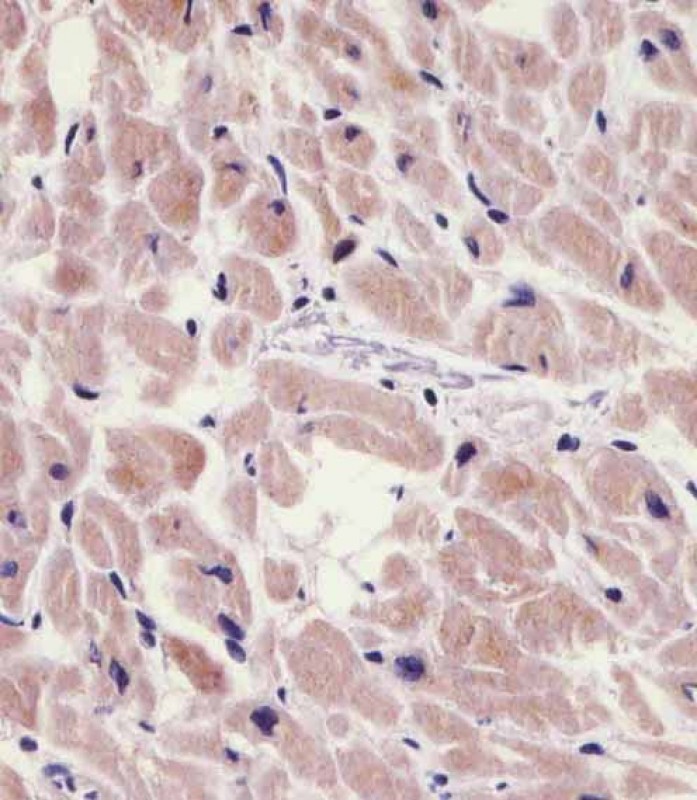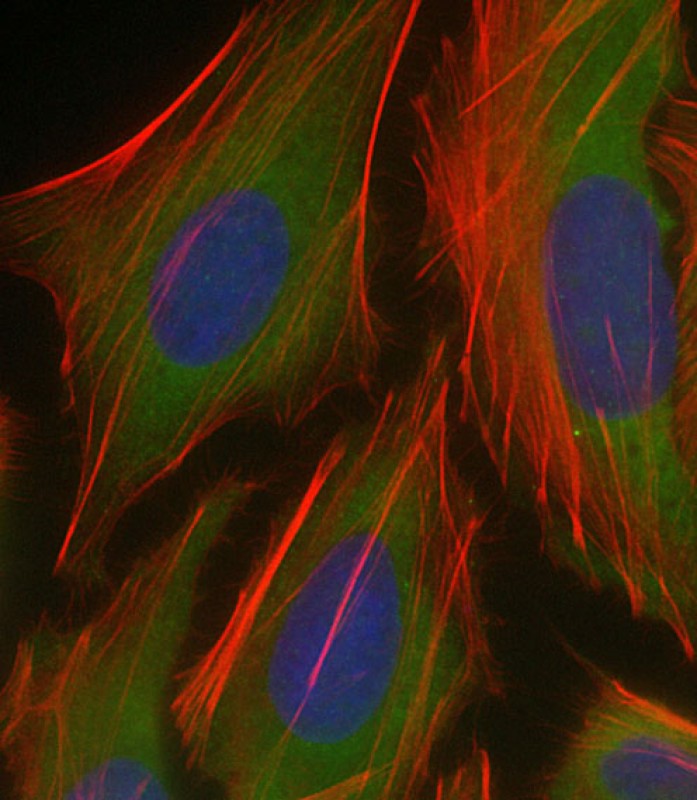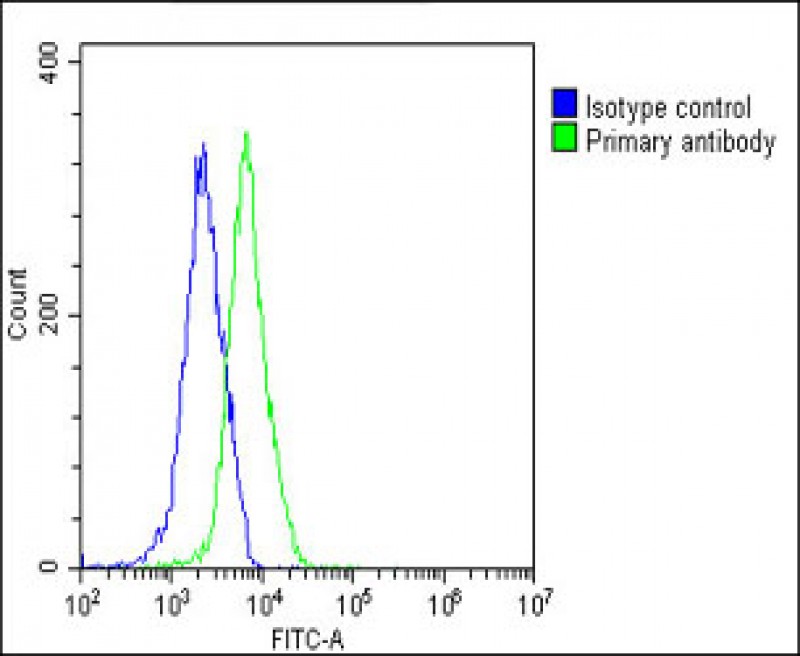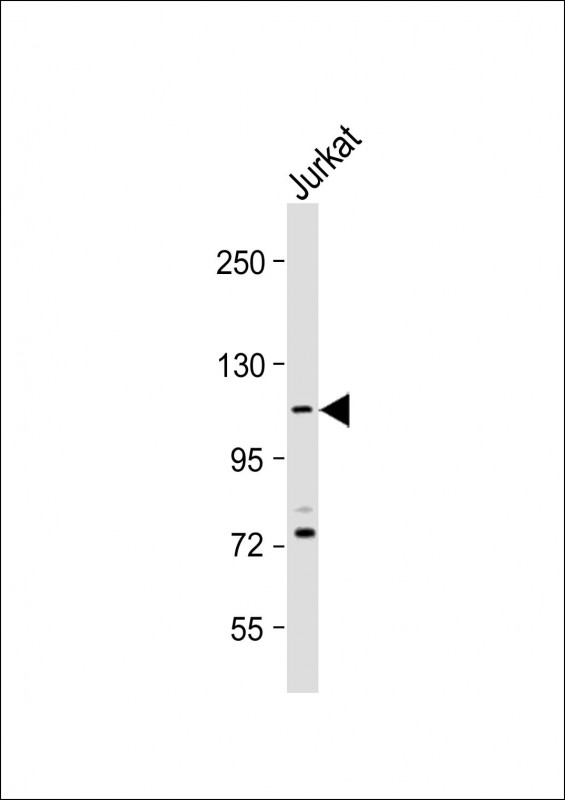PKN1 Antibody (C-Term)
Purified Rabbit Polyclonal Antibody (Pab)
- 产品详情
- 实验流程
- 背景知识
Application
| WB, FC, IF, IHC-P, E |
|---|---|
| Primary Accession | Q16512 |
| Other Accession | A1A4I4, A1Z7T0 |
| Reactivity | Human, Rat, Mouse |
| Predicted | Bovine |
| Host | Rabbit |
| Clonality | polyclonal |
| Isotype | Rabbit IgG |
| Calculated MW | 103932 Da |
| Gene ID | 5585 |
|---|---|
| Other Names | Serine/threonine-protein kinase N1, 2.7.11.13, Protease-activated kinase 1, PAK-1, Protein kinase C-like 1, Protein kinase C-like PKN, Protein kinase PKN-alpha, Protein-kinase C-related kinase 1, Serine-threonine protein kinase N, PKN1, PAK1, PKN, PRK1, PRKCL1 |
| Target/Specificity | This PKN1 antibody is generated from a rabbit immunized with a KLH conjugated synthetic peptide between 836-870 amino acids from human PKN1. |
| Dilution | WB~~1:2000 FC~~1:25 IF~~1:25 IHC-P~~1:100~500 E~~Use at an assay dependent concentration. |
| Format | Purified polyclonal antibody supplied in PBS with 0.09% (W/V) sodium azide. This antibody is purified through a protein A column, followed by peptide affinity purification. |
| Storage | Maintain refrigerated at 2-8°C for up to 2 weeks. For long term storage store at -20°C in small aliquots to prevent freeze-thaw cycles. |
| Precautions | PKN1 Antibody (C-Term) is for research use only and not for use in diagnostic or therapeutic procedures. |
| Name | PKN1 |
|---|---|
| Synonyms | PAK1, PKN, PRK1, PRKCL1 |
| Function | PKC-related serine/threonine-protein kinase involved in various processes such as regulation of the intermediate filaments of the actin cytoskeleton, cell migration, tumor cell invasion and transcription regulation. Part of a signaling cascade that begins with the activation of the adrenergic receptor ADRA1B and leads to the activation of MAPK14. Regulates the cytoskeletal network by phosphorylating proteins such as VIM and neurofilament proteins NEFH, NEFL and NEFM, leading to inhibit their polymerization. Phosphorylates 'Ser-575', 'Ser-637' and 'Ser-669' of MAPT/Tau, lowering its ability to bind to microtubules, resulting in disruption of tubulin assembly. Acts as a key coactivator of androgen receptor (AR)-dependent transcription, by being recruited to AR target genes and specifically mediating phosphorylation of 'Thr-11' of histone H3 (H3T11ph), a specific tag for epigenetic transcriptional activation that promotes demethylation of histone H3 'Lys-9' (H3K9me) by KDM4C/JMJD2C. Phosphorylates HDAC5, HDAC7 and HDAC9, leading to impair their import in the nucleus. Phosphorylates 'Thr-38' of PPP1R14A, 'Ser-159', 'Ser-163' and 'Ser-170' of MARCKS, and GFAP. Able to phosphorylate RPS6 in vitro. |
| Cellular Location | Cytoplasm. Nucleus Endosome. Cell membrane {ECO:0000250|UniProtKB:Q63433}; Peripheral membrane protein {ECO:0000250|UniProtKB:Q63433}. Cleavage furrow. Midbody Note=Associates with chromatin in a ligand-dependent manner Localization to endosomes is mediated via its interaction with RHOB Association to the cell membrane is dependent on Ser-377 phosphorylation. Accumulates during telophase at the cleavage furrow and finally concentrates around the midbody in cytokinesis {ECO:0000250|UniProtKB:Q63433, ECO:0000269|PubMed:17332740} |
| Tissue Location | Found ubiquitously. Expressed in heart, brain, placenta, lung, skeletal muscle, kidney and pancreas. Expressed in numerous tumor cell lines, especially in breast tumor cells |
For Research Use Only. Not For Use In Diagnostic Procedures.
Provided below are standard protocols that you may find useful for product applications.
BACKGROUND
PKC-related serine/threonine-protein kinase involved in various processes such as regulation of the intermediate filaments of the actin cytoskeleton, cell migration, tumor cell invasion and transcription regulation. Regulates the cytoskeletal network by phosphorylating proteins such as VIM and neurofilament proteins NEFH, NEFL and NEFM, leading to inhibit their polymerization. Phosphorylates 'Ser-575', 'Ser-637' and 'Ser-669' of MAPT/Tau, lowering its ability to bind to microtubules, resulting in disruption of tubulin assembly. Acts as a key coactivator of androgen receptor (ANDR)-dependent transcription, by being recruited to ANDR target genes and specifically mediating phosphorylation of 'Thr-11' of histone H3 (H3T11ph), a specific tag for epigenetic transcriptional activation that promotes demethylation of histone H3 'Lys-9' (H3K9me) by KDM4C/JMJD2C. Phosphorylates HDAC5, HDAC7 and HDAC9, leading to impair their import in the nucleus. Phosphorylates 'Thr-38' of PPP1R14A, 'Ser- 159', 'Ser-163' and 'Ser-170' of MARCKS, and GFAP. Able to phosphorylate RPS6 in vitro.
REFERENCES
Mukai H.,et al.Biochem. Biophys. Res. Commun. 199:897-904(1994).
Palmer R.H.,et al.Eur. J. Biochem. 227:344-351(1995).
Ota T.,et al.Nat. Genet. 36:40-45(2004).
Grimwood J.,et al.Nature 428:529-535(2004).
Palmer R.H.,et al.FEBS Lett. 356:5-8(1994).
终于等到您。ABCEPTA(百远生物)抗体产品。
点击下方“我要评价 ”按钮提交您的反馈信息,您的反馈和评价是我们最宝贵的财富之一,
我们将在1-3个工作日内处理您的反馈信息。
如有疑问,联系:0512-88856768 tech-china@abcepta.com.























 癌症的基本特征包括细胞增殖、血管生成、迁移、凋亡逃避机制和细胞永生等。找到癌症发生过程中这些通路的关键标记物和对应的抗体用于检测至关重要。
癌症的基本特征包括细胞增殖、血管生成、迁移、凋亡逃避机制和细胞永生等。找到癌症发生过程中这些通路的关键标记物和对应的抗体用于检测至关重要。 为您推荐一个泛素化位点预测神器——泛素化分析工具,可以为您的蛋白的泛素化位点作出预测和评分。
为您推荐一个泛素化位点预测神器——泛素化分析工具,可以为您的蛋白的泛素化位点作出预测和评分。 细胞自噬受体图形绘图工具为你的蛋白的细胞受体结合位点作出预测和评分,识别结合到自噬通路中的蛋白是非常重要的,便于让我们理解自噬在正常生理、病理过程中的作用,如发育、细胞分化、神经退化性疾病、压力条件下、感染和癌症。
细胞自噬受体图形绘图工具为你的蛋白的细胞受体结合位点作出预测和评分,识别结合到自噬通路中的蛋白是非常重要的,便于让我们理解自噬在正常生理、病理过程中的作用,如发育、细胞分化、神经退化性疾病、压力条件下、感染和癌症。









